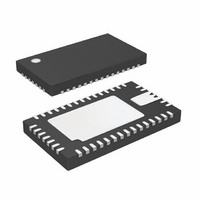LTC3577EUFF#PBF Linear Technology, LTC3577EUFF#PBF Datasheet - Page 37

LTC3577EUFF#PBF
Manufacturer Part Number
LTC3577EUFF#PBF
Description
IC PWR MANAGEMENT HANDHELD 44QFN
Manufacturer
Linear Technology
Datasheet
1.LTC3577EUFFPBF.pdf
(54 pages)
Specifications of LTC3577EUFF#PBF
Applications
Handheld/Mobile Devices
Voltage - Supply
4.35 V ~ 5.5 V
Operating Temperature
-40°C ~ 85°C
Mounting Type
Surface Mount
Package / Case
44-QFN
Lead Free Status / RoHS Status
Lead free / RoHS Compliant
Current - Supply
-
Available stocks
Company
Part Number
Manufacturer
Quantity
Price
OPERATION
When dimming via PWM the LED driver and boost converter
are both turned on and off together. This allows some
degree of additional control over the LED current, and in
some cases may offer a more effi cient method of dimming
since the boost could be operated at an optimal effi ciency
point and then pulsed for the desired LED intensity.
The PWM mode, if enabled, is set up using 3 values;
PWMNUM[3:0] and PWMDEN[3:0] in the I
Register” and PWMCLK, set by PWMC2 and PWMC1 in
the I
Table 6. PWM Clock Frequency
Using the PWM control, a 4-bit internally generated PWM is
possible as additional dimming. Using these control bits a
number of PWM duty cycles and frequencies are available
in the 100Hz to 500Hz range. This range was selected to
be below the audio range and above the frequency where
the PWM is visible.
For example, given PWMC2 = 1, PWMC1 = 0, PWM-
NUM[3:0] = 0111 and PWMDEN[3:0] = 1100 then the duty
cycle will be 58.3% and PWM frequency will be 243Hz.
If PWMNUM is set to 0 then the duty cycle will be 0%
and the current sink will effectively be off. If PWMNUM
is programmed to a value larger than PWMDEN the duty
cycle will be 100% and the current sink will effectively be
constant. PWMDEN and PWMNUM may both be changed
to result in 73 different duty cycle possibilities and 41 dif-
ferent PWM frequencies between 8.77kHz and 100Hz.
Duty Cycle =
Frequency =
2
PWMC2
C “LED Control Register.”
0
0
1
1
PWMCLK
PWMDEN
PWMNUM
PWMDEN
PWMC1
0
1
0
1
PWMCLK
8.77kHz
4.39kHz
2.92kHz
2.19kHz
2
C “LED PWM
When PWM mode is enabled, a small (2μA) standby current
source is always enabled on the I
this is to have some current fl owing in the LEDs at all times.
This helps to reduce the magnitude of the voltage swing
on the I
Fixed Boost Output
Setting MD1 to 1 and MD2 to 0 selects the fi xed high voltage
boost mode. This mode can be used to generate output
voltages at or greater than V
boost converter the I
and will regulate the output voltage such that the voltage
on the I
Figure 17 shows a fi xed 12V output generated using the
boost converter in the fi xed high voltage boost mode. Any
output voltage up to 40V may be programmed by select-
ing appropriate values for the R1 and R2 voltage divider
from the equation:
Values for R2 should be kept below 24.3k to keep the pole
at I
The boost is designed primarily as a high voltage, high duty
cycle converter. When operating with a lower boost ratio,
a larger output capacitor, 10μF , should be used. Operating
with a very low duty cycle will cause cycle skipping which
will increase ripple.
V
LED
BOOST
Figure 17. Fixed 12V/75mA Boost Output Application
beyond cross over.
LED
LED
LTC3577
= 0.8V •
pin as the current is pulsed on and off.
pin is 800mV.
LED_OV
I
LED_FS
V
I
OUT
3577 F17
SW
SW
SW
LED
LTC3577/LTC3577-1
⎛
⎝ ⎜
39
3
18
19
20
22
9
R2
LED
R1
800mV V
L4
10μH
LPS4018-103ML
+ 1
pin becomes the feedback pin,
ZLLS400
22μF
C1
⎞
⎠ ⎟
D12
REF
OUT
. When confi gured as a
LED
R1
301k
R2
21.5k
pin. The purpose of
C2
10μF
10V
BOOST
37
3577fa













